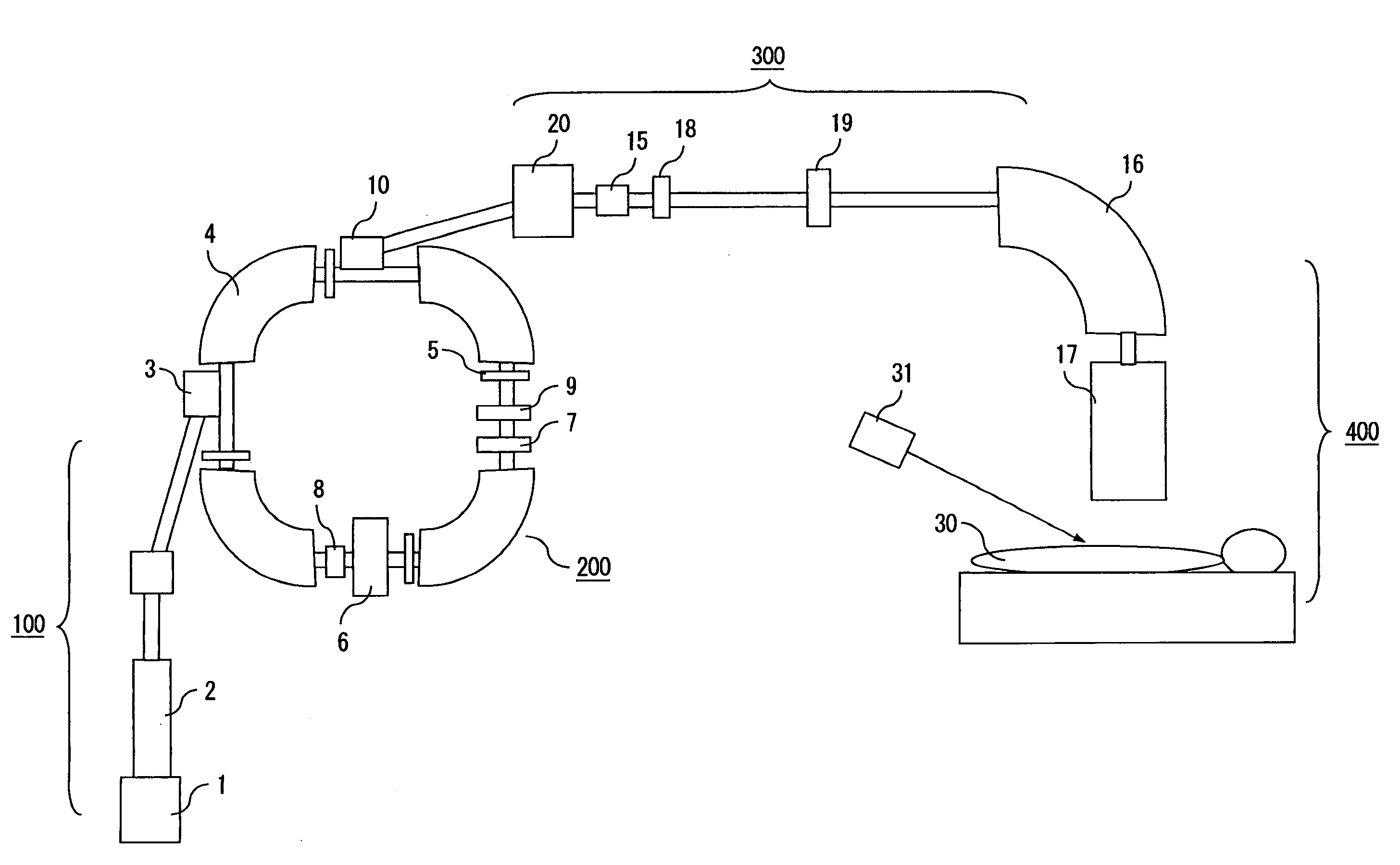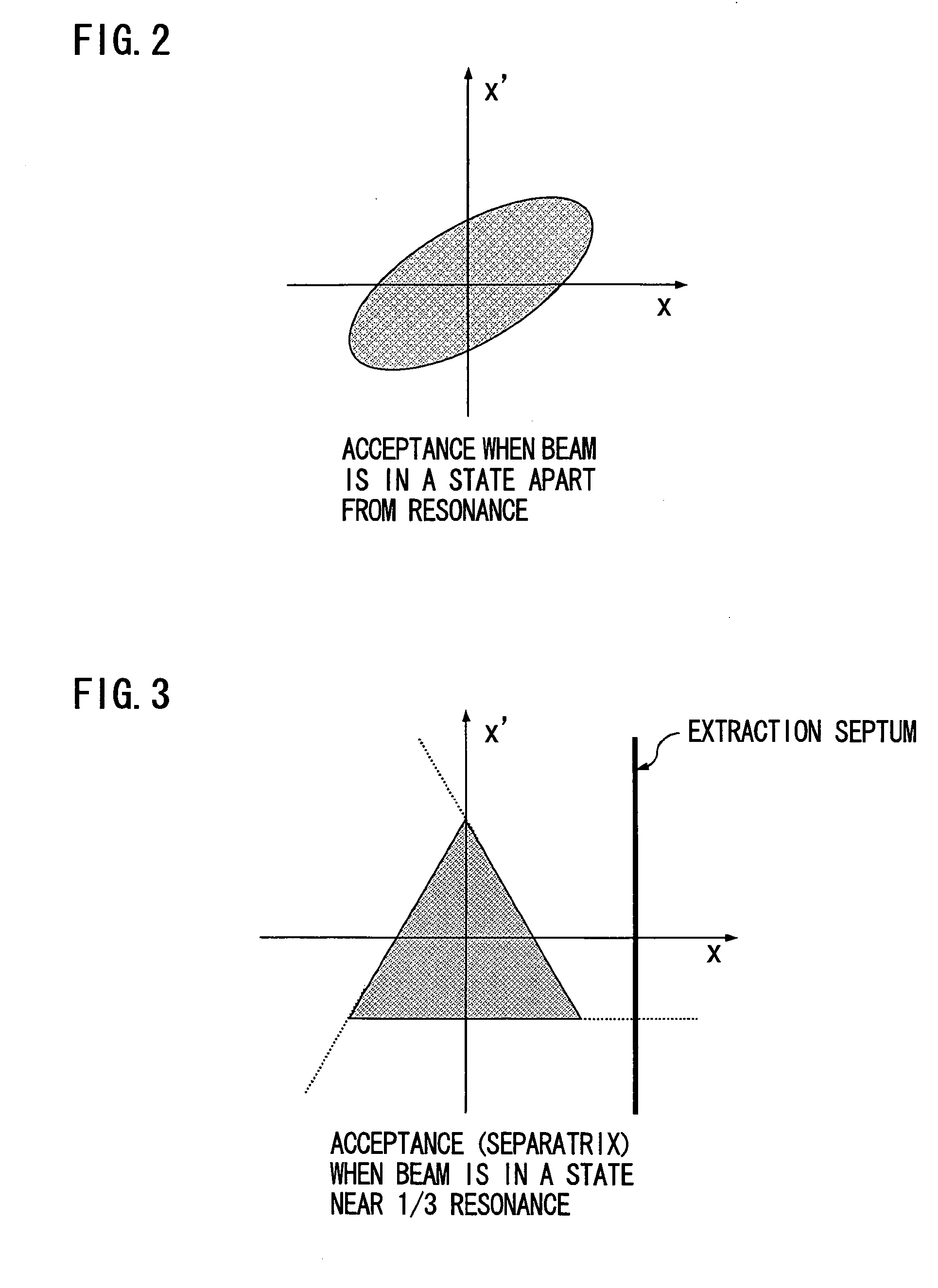Charged-particle beam accelerator, particle beam radiation therapy system using the charged-particle beam accelerator, and method of operating the particle beam radiation therapy system
a radiation therapy system and accelerator technology, applied in accelerators, electric discharge tubes, electrical devices, etc., can solve the problems of system becoming considerably costly, rf-ko is not disclosed in the publication, and the reliability of equipment is not known, so as to achieve efficient irradiation and reduce unwanted dose
- Summary
- Abstract
- Description
- Claims
- Application Information
AI Technical Summary
Benefits of technology
Problems solved by technology
Method used
Image
Examples
first embodiment
[0037]A first embodiment of the invention is now described with reference to the accompanying drawings.
[0038]FIG. 1 is a diagram schematically showing a particle beam radiation system in which a charged-particle beam accelerator 200 and a particle beam radiation therapy system are combined. Referring to this Figure, the charged-particle beam accelerator 200 includes an injection septum 3, four main bending electromagnet units 4, four main quadrupole electromagnet units 5, a high-frequency acceleration unit 6, a sextupole electromagnet unit 7, an RF-KO unit 8 constituting a high-frequency generator, an extraction quadrupole electromagnet unit 9 and an extraction septum 10. The particle beam radiation system includes a beam injection apparatus 100 provided in an upstream stage of the charged-particle beam accelerator 200 for injecting a low-energy beam thereinto. The beam injection apparatus 100 includes an ion source 1 and a linear accelerator 2.
[0039]A charged-particle beam extracte...
second embodiment
[0059]A second embodiment of the invention is now described. While the RF-KO unit (radio frequency generating unit) 8 is turned off when the extraction quadrupole electromagnet unit 9 is activated in the foregoing first embodiment as can be seen from FIGS. 6D and 6F, the same advantageous effects as explained above with reference to the first embodiment can be obtained even if the radio frequency generating unit 8 is of a type which generates a frequency-modulated (FM) signal of which frequency is varied over a range of f1 to f2 and is continuously operated as depicted in FIG. 8F. Also, if two such radio frequency generating units 8 are used as in prior art examples to generate FM signals of which phases are offset from each other as shown in FIGS. 9F and 9G, it becomes possible to extract particles more efficiently. The same advantageous effects can also be obtained even if the radio frequency generating unit 8 is of a type which continuously generates a signal containing frequency...
third embodiment
[0065]A third embodiment of the invention is now described. It is advantageous to install the beam blocking electromagnet unit 18 for generating a magnetic field only during a period between the extraction start signal (FIG. 6B) and the dose complete signal (FIG. 6C) in the beam transport line 300 as shown in FIG. 1 so that no particle beam would be transported to the beam delivery unit 17 even when the beam is extracted at a point in time not between the extraction start signal (FIG. 6B) and the dose complete signal (FIG. 6C) due to noise generated by any of power supplies of the main bending electromagnet units 4, the main quadrupole electromagnet units 5 or the RF-KO unit 8, for example.
[0066]FIG. 11G shows an operating pattern of the beam blocking electromagnet unit 18. In this embodiment, the bending electromagnet unit 20 disposed in the beam transport line 300 is set to bend the beam by a smaller angle so that the beam deviates from a central axis of a normal beam path and col...
PUM
 Login to View More
Login to View More Abstract
Description
Claims
Application Information
 Login to View More
Login to View More - R&D
- Intellectual Property
- Life Sciences
- Materials
- Tech Scout
- Unparalleled Data Quality
- Higher Quality Content
- 60% Fewer Hallucinations
Browse by: Latest US Patents, China's latest patents, Technical Efficacy Thesaurus, Application Domain, Technology Topic, Popular Technical Reports.
© 2025 PatSnap. All rights reserved.Legal|Privacy policy|Modern Slavery Act Transparency Statement|Sitemap|About US| Contact US: help@patsnap.com



